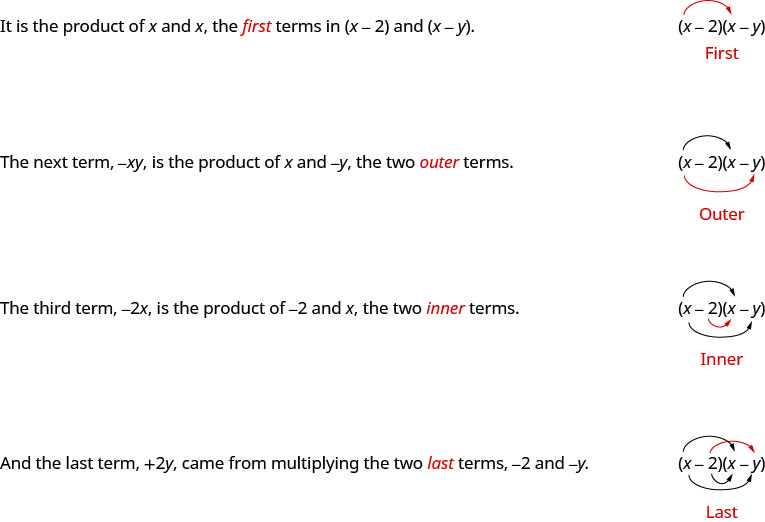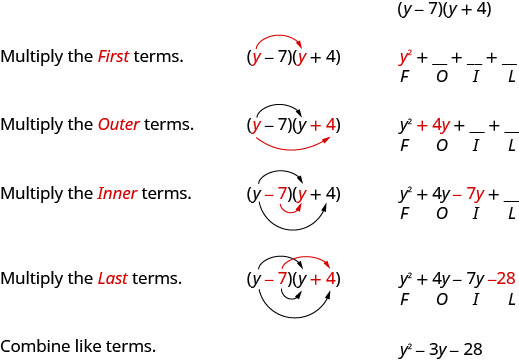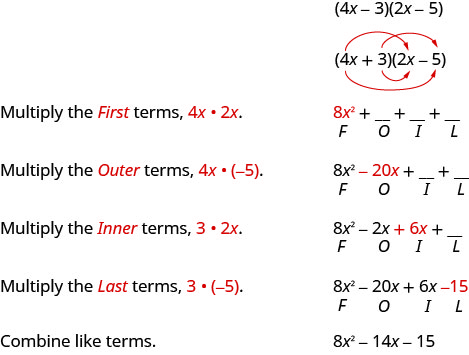5.3 Multiply Polynomials
Learning Objectives
By the end of this section, you will be able to:
- Multiply a polynomial by a monomial
- Multiply a binomial by a binomial
- Multiply a trinomial by a binomial
Try it
Before you get started, take this readiness quiz:
1) Distribute: [latex]2(x+3)[/latex]
2) Combine like terms: [latex]{x}^{2}+9x+7x+63[/latex]
Multiply a Polynomial by a Monomial
We have used the Distributive Property to simplify expressions like [latex]2(x-3)[/latex]. You multiplied both terms in the parentheses, [latex]x[/latex] and [latex]3[/latex] by [latex]2[/latex], to get [latex]2x-6[/latex]. With this chapter’s new vocabulary, you can say you were multiplying a binomial, [latex]x-3[/latex], by a monomial, [latex]2[/latex].
Multiplying a binomial by a monomial is nothing new for you! Here’s an example:
Try It
3) Multiply: [latex]5(x+7)[/latex]
Solution
[latex]5x+35[/latex]
4) Multiply: [latex]3(y+13)[/latex]
Solution
[latex]3y+39[/latex]
Try It
5) Multiply: [latex]x(x-7)[/latex]
Solution
[latex]{x}^{2}-7x[/latex]
6) Multiply: [latex]d(d-11)[/latex]
Solution
[latex]{d}^{2}-11d[/latex]
Try It
7) Multiply: [latex]5x(x+4y)[/latex]
Solution
[latex]5{x}^{2}+20xy[/latex]
8) Multiply: [latex]2p(6p+r)[/latex]
Solution
[latex]12{p}^{2}+2pr[/latex]
Try It
9) Multiply: [latex]-3y(5{y}^{2}+8y-7)[/latex]
Solution
[latex]-15{y}^{3}-24{y}^{2}+21y[/latex]
10) Multiply: [latex]4{x}^{2}(2{x}^{2}-3x+5)[/latex]
Solution
[latex]8{x}^{4}-24{x}^{3}+20{x}^{2}[/latex]
Try It
11) Multiply: [latex]4x(3{x}^{2}-5x+3)[/latex]
Solution
[latex]12{x}^{3}-20{x}^{2}+12x[/latex]
12) Multiply: [latex]-6{a}^{3}(3{a}^{2}-2a+6)[/latex]
Solution
[latex]-18{a}^{5}+12{a}^{4}-36{a}^{3}[/latex]
Try It
13) Multiply: [latex](x+8)p[/latex]
Solution
[latex]xp+8p[/latex]
14) Multiply: [latex](a+4)p[/latex]
Solution
[latex]ap+4p[/latex]
Multiply a Binomial by a Binomial
Just like there are different ways to represent multiplication of numbers, there are several methods that can be used to multiply a binomial times a binomial. We will start by using the Distributive Property.
Multiply a Binomial by a Binomial Using the Distributive Property
Look at below table, where we multiplied a binomial by a monomial.
Notice that before combining like terms, you had four terms. You multiplied the two terms of the first binomial by the two terms of the second binomial—four multiplications.
Example 5.3.7
Try It
15) Multiply: [latex](x+8)(x+9)[/latex]
Solution
[latex]{x}^{2}+17x+72[/latex]
16) Multiply: [latex](5x+9)(4x+3)[/latex]
Solution
[latex]20{x}^{2}+51x+27[/latex]
Example 5.3.8
Multiply: [latex](2y+5)(3y+4)[/latex]
Try It
17) Multiply: [latex](3b+5)(4b+6)[/latex]
Solution
[latex]12{b}^{2}+38b+30[/latex]
18) Multiply: [latex](a+10)(a+7)[/latex]
Solution
[latex]{a}^{2}+17a+70[/latex]
Example 5.3.9
Multiply: [latex](4y+3)(2y-5)[/latex]
Solution
Step 1: Distribute.
[latex]4y\;{\color{red}{(2y\;-\;5)}}\;+\;3\;{\color{red}{(2y\;-\;5)}}[/latex]
Step 2: Distribute again.
[latex]8y^2\;-\;20y\;+\;6y\;-\;15[/latex]
Step 3: Combine like terms.
[latex]8y^2\;-\;14y\;-\;15[/latex]
Try It
19) Multiply: [latex](5y+2)(6y-3)[/latex]
Solution
[latex]30{y}^{2}-3y-6[/latex]
20) Multiply: [latex](3c+4)(5c-2)[/latex]
Solution
[latex]15{c}^{2}+14c-8[/latex]
Try It
21) Multiply: [latex](a+7)(a-b)[/latex]
Solution
[latex]{a}^{2}-ab+7a-7b[/latex]
22) Multiply: [latex](x+5)(x-y)[/latex]
Solution
[latex]{x}^{2}-xy+5x-5y[/latex]
Multiply a Binomial by a Binomial Using the FOIL Method
Remember that when you multiply a binomial by a binomial you get four terms. Sometimes you can combine like terms to get a trinomial, but sometimes, like in the Example 5.3.10 there are no like terms to combine.
Let’s look at the last example again and pay particular attention to how we got the four terms.
Where did the first term, [latex]{x}^{2}[/latex], come from?

We abbreviate “First, Outer, Inner, Last” as FOIL. The letters stand for ‘First, Outer, Inner, Last’. The word FOIL is easy to remember and ensures we find all four products.
Let’s look at [latex](x+3)(x+7)[/latex].
Notice how the terms in third line fit the FOIL pattern.
Now we will do an example where we use the FOIL pattern to multiply two binomials.
Try It
23) Multiply using the FOIL method: [latex](x+6)(x+8)[/latex]
Solution
[latex]{x}^{2}+14x+48[/latex]
24) Multiply using the FOIL method: [latex](y+17)(y+3)[/latex]
Solution
[latex]{y}^{2}+20y+51[/latex]
We summarize the steps of the FOIL method below. The FOIL method only applies to multiplying binomials, not other polynomials!
When you multiply by the FOIL method, drawing the lines will help your brain focus on the pattern and make it easier to apply.
Try It
25) Multiply: [latex](x-7)(x+5)[/latex]
Solution
[latex]{x}^{2}-2x-35[/latex]
26) Multiply: [latex](b-3)(b+6)[/latex]
Solution
[latex]{b}^{2}+3b-18[/latex]
Try It
27) Multiply: [latex](3x+7)(5x-2)[/latex]
Solution
[latex]15{x}^{2}+29x-14[/latex]
28) Multiply: [latex](4y+5)(4y-10)[/latex]
Solution
[latex]16{y}^{2}-20y-50[/latex]
The final products in the last four examples were trinomials because we could combine the two middle terms. This is not always the case.
Example 5.3.14
Multiply: [latex](3x-y)(2x-5)[/latex]
Solution

Step 1: Multiply the First.
[latex]\underset{F}{\color{red}{6x^2}}\;+\;\underset{O}{\_\_}\;+\;\underset{I}{\_\_}\;+\;\underset{L}{\;\_\_}[/latex]
Step 2: Multiply the Outer.
[latex]\underset{F}{\color{red}{6x^2}}\;{\color{red}{-}}\;\underset{O}{\color{red}{15x}}\;+\;\underset{I}{\_\_}\;+\;\underset{L}{\;\_\_}[/latex]
Step 3: Multiply the Inner.
[latex]\underset{F}{6x^2}\;-\;\underset{O}{15x}\;{\color{red}{-}}\;\underset{I}{\color{red}{2xy}}\;+\;\underset{L}{\;\_\_}[/latex]
Step 4: Multiply the Last.
[latex]\underset{F}{6x^2}\;-\;\underset{O}{15x}\;-\;\underset{I}{2xy}\;{\color{red}{+}}\;\underset{L}{\color{red}{5y}}[/latex]
Step 5: Combine like terms—there are none.
[latex]6x^2\;-\;15x\;-\;2xy\;+\;5y[/latex]
Try It
29) Multiply: [latex](10c-d)(c-6)[/latex]
Solution
[latex]10{c}^{2}-60c-cd+6d[/latex]
30) Multiply: [latex](7x-y)(2x-5)[/latex]
Solution
[latex]14{x}^{2}-35x-2xy+10y[/latex]
Be careful of the exponents in the next example.
Example 5.3.15
Multiply: [latex]({n}^{2}+4)(n-1)[/latex]
Solution

Step 1: Multiply the First.
[latex]\underset{F}{\color{red}{n^3}}\;+\;\underset{O}{\_\_}\;+\;\underset{I}{\_\_}\;+\;\underset{L}{\;\_\_}[/latex]
Step 2: Multiply the Outer.
[latex]\underset{F}{n^3}\;{\color{red}{-}}\;\underset{O}{\color{red}{n^2}}\;+\;\underset{I}{\_\_}\;+\;\underset{L}{\;\_\_}[/latex]
Step 3: Multiply the Inner.
[latex]\underset{F}{n^3}\;-\;\underset{O}{n^2}\;{\color{red}{+}}\;\underset{I}{\color{red}{4n}}\;+\;\underset{L}{\;\_\_}[/latex]
Step 4: Multiply the Last.
[latex]\underset{F}{n^3}\;-\;\underset{O}{n^2}\;+\;\underset{I}{4n}\;{\color{red}{-}}\;\underset{L}{\color{red}{4}}[/latex]
Step 5: Combine like terms—there are none.
[latex]n^3\;-\;n^2\;+\;4n\;-\;4[/latex]
Try It
31) Multiply: [latex]({x}^{2}+6)(x-8)[/latex]
Solution
[latex]{x}^{3}-8{x}^{2}+6x-48[/latex]
32) Multiply: [latex]({y}^{2}+7)(y-9)[/latex]
Solution
[latex]{y}^{3}-9{y}^{2}+7y-63[/latex]
Example 5.3.16
Multiply: [latex](3pq+5)(6pq-11)[/latex]
Solution

Step 1: Multiply the First.
[latex]\underset F{\color{red}{18p^2q^2}}\;+\;\underset O{\_\_}\;+\;\underset I{\_\_}\;+\;\underset L{\_\_}[/latex]
Step 2: Multiply the Outer.
[latex]\underset F{18p^2q^2}\;{\color{red}{-}}\;\underset{O}{\color{red}{33pq}}\;+\;\underset I{\_\_}\;+\;\underset L{\_\_}[/latex]
Step 3: Multiply the Inner.
[latex]\underset F{18p^2q^2}\;-\;\underset O{33pq}\;{\color{red}{+}}\;\underset{I}{\color{red}{30pq}}\;+\;\underset L{\_\_}[/latex]
Step 4: Multiply the Last.
[latex]\underset F{18p^2q^2}\;-\;\underset O{33pq}\;+\;\underset I{30pq}\;{\color{red}{-}}\;{\color{red}{\underbrace{55}_{\color{black}{L}}}}[/latex]
Step 5: Combine like terms—there are none.
[latex]18p^2q^2\;-\;3pq\;-\;55\;[/latex]
Try It
33) Multiply: [latex](2ab+5)(4ab-4)[/latex]
Solution
[latex]8{a}^{2}{b}^{2}+12ab-20[/latex]
34) Multiply: [latex](2xy+3)(4xy-5)[/latex]
Solution
[latex]8{x}^{2}{y}^{2}+2xy-15[/latex]
Multiply a Binomial by a Binomial Using the Vertical Method
The FOIL method is usually the quickest method for multiplying two binomials, but it only works for binomials. You can use the Distributive Property to find the product of any two polynomials. Another method that works for all polynomials is the Vertical Method. It is very much like the method you use to multiply whole numbers. Look carefully at this example of multiplying two-digit numbers.
[latex]\begin{alignat*}{3} &\;\;\;23\\ &\underline{\times46}\;\\ &\;\;138\;&&\;\text{partial product}\;\;\;\;\;&&\text{Start by multiplying 23 by 6 to get 138.}\\ &\underline{\;\;92\;\;}&&\;\text{partial product}\;\;\;\;\;&&\text{Next, multiply 23 by 4, lining up the partial product in the correct columns.}\\ &1058\;&&\;\text{product}\;\;\;\;\;&&\text{Last you add the partial products.} \end{alignat*}[/latex]
Now we’ll apply this same method to multiply two binomials.
Example 5.3.17
Multiply using the Vertical Method: [latex](3y-1)(2y-6)[/latex]
Solution
It does not matter which binomial goes on the top.
Step 1: Multiply [latex]3y -1[/latex] by [latex]-6[/latex]
Step 2: Multiply [latex]3y-1[/latex] by [latex]2y[/latex]
Step 3: Add like terms.
Notice the partial products are the same as the terms in the FOIL method.
| [latex]\begin{align*}(3y-1)(2y-6)\\{\color{blue}{\underline{6y2^2-2y}}}{\color{red}{\underline{\;-18y+6}}}\\6y^2-20y+6\end{align*}[/latex] | [latex]\begin{align*}3y-1\\\underline{\times2y-6}\\{\color{red}{-18y+6}}\\{\color{blue}{6y^2-2y}}\;\;\;\;\;\;\;\\\overline{6y^2-20x+6}\end{align*}[/latex] |
Try It
35) Multiply using the Vertical Method: [latex](5m-7)(3m-6)[/latex]
Solution
[latex]15{m}^{2}-51m+42[/latex]
36) Multiply using the Vertical Method: [latex](6b-5)(7b-3)[/latex]
Solution
[latex]42{b}^{2}-53b+15[/latex]
We have now used three methods for multiplying binomials. Be sure to practice each method, and try to decide which one you prefer. The methods are listed here all together, to help you remember them.
Multiplying Two Binomials
HOW TO
To multiply binomials, use the:
- Distributive Property
- FOIL Method
- Vertical Method
Remember, FOIL only works when multiplying two binomials.
Multiply a Trinomial by a Binomial
We have multiplied monomials by monomials, monomials by polynomials, and binomials by binomials. Now we’re ready to multiply a trinomial by a binomial. Remember, FOIL will not work in this case, but we can use either the Distributive Property or the Vertical Method. We first look at an example using the Distributive Property.
Try It
37) Multiply using the Distributive Property: [latex](y-3)({y}^{2}-5y+2)[/latex]
Solution
[latex]{y}^{3}-8{y}^{2}+17y-6[/latex]
38) Multiply using the Distributive Property: [latex](x+4)(2{x}^{2}-3x+5)[/latex]
Solution
[latex]2{x}^{3}+5{x}^{2}-7x+20[/latex]
Now let’s do this same multiplication using the Vertical Method.
Example 5.3.19
Multiply using the Vertical Method: [latex](b+3)(2{b}^{2}-5b+8)[/latex]
Solution
Step 1: Multiply [latex](2b^2-5b+8)[/latex] by [latex]3[/latex].
[latex]\begin{align*} 2b^2-5b+8&\\ \times\;\;\;\;\;\;\;b+3&\\ \overline{6b^2-15b+24}& \end{align*}[/latex]
Step 2: Multiply [latex](2b^2-5b+8)[/latex] by [latex]b[/latex].
[latex]2b^3\;-\;5b^2\;+\;8b[/latex]
Step 3: Add like terms.
[latex]2b^3\;+\;b^2\;-\;7b\;+\;24[/latex]
It is easier to put the polynomial with fewer terms on the bottom because we get fewer partial products this way.
Try It
39) Multiply using the Vertical Method: [latex](y-3)({y}^{2}-5y+2)[/latex]
Solution
[latex]{y}^{3}-8{y}^{2}+17y-6[/latex]
40) Multiply using the Vertical Method: [latex](x+4)(2x^2-3x+5)[/latex]
Solution
[latex]2x^3+5x^2-7x+20[/latex]
We have now seen two methods you can use to multiply a trinomial by a binomial. After you practice each method, you’ll probably find you prefer one way over the other. We list both methods are listed here, for easy reference.
Multiplying a Trinomial by a Binomial
HOW TO
To multiply a trinomial by a binomial, use the:
- Distributive Property
- Vertical Method
Access these online resources for additional instruction and practice with multiplying polynomials:
Key Concepts
- FOIL Method for Multiplying Two Binomials—To multiply two binomials:
- Multiply the First terms.
- Multiply the Outer terms.
- Multiply the Inner terms.
- Multiply the Last terms.
- Multiplying Two Binomials—To multiply binomials, use the:
- Distributive Property (Example 5.3.7)
- FOIL Method (Example 5.3.11)
- Vertical Method (Example 5.3.17)
- Multiplying a Trinomial by a Binomial—To multiply a trinomial by a binomial, use the:
- Distributive Property (Example 5.3.18)
- Vertical Method (Example 5.3.19)
Self Check
After completing the exercises, use this checklist to evaluate your mastery of the objectives of this section.
What does this checklist tell you about your mastery of this section? What steps will you take to improve?





















